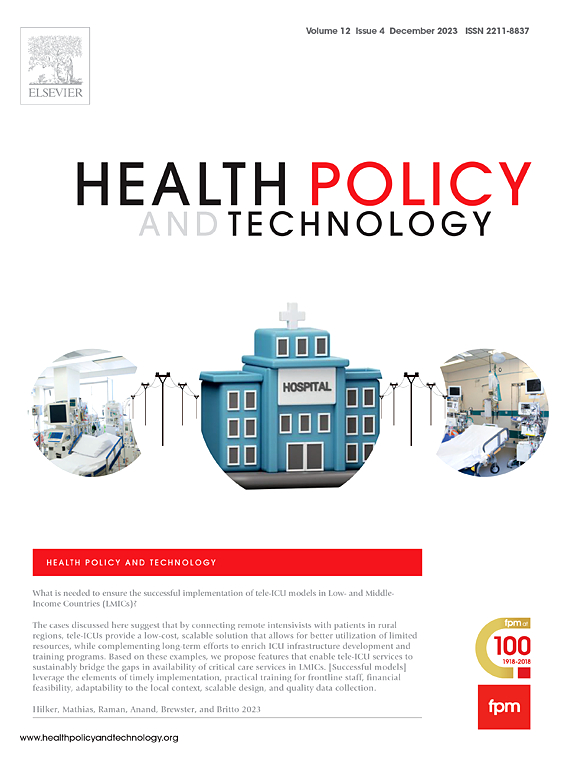医疗保健系统转型:新加坡一家大型三级医疗医院的Healthier-SG的结果
IF 3.7
3区 医学
Q1 HEALTH POLICY & SERVICES
引用次数: 0
摘要
目的healthier - sg是医疗保健系统的一个重大转变,其重点是主动预防个人生病。我们的目的是确定Healthier-SG的引入是否与入院患者预后的改变有关。方法回顾性队列研究年龄≥21岁,在实施Healthier-SG前18个月(2022年1月至2023年6月)和实施后6个月(2023年7月至12月)入院的患者。提取相关患者信息。结果109,451例住院患者被纳入加班,30,692例(28.0%)在healther - sg后入院。对于可以在社区管理的医疗状况,在Healthier-SG之后,痴呆症(0.2% vs. 0.1% P = 0.003)和周围血管疾病(0.4% vs. 0.3% P = 0.011)的入院率显著下降,但对大多数其他状况没有差异(所有P >;0.05)。患者住院时间[HLOS,几何平均(GM), 3.8天之前vs. 3.5天之后]和住院死亡率(3.7% vs. 2.9%,所有P <;0.001),在Healthier-SG后显著降低。纳入SingHealth集群的患者在2023年的卧床天数(GM, 4.92 vs 4.77天,p = 0.022)也在healther - sg后减少。多因素回归分析显示,实施Healthier-SG与HLOS的变化有统计学意义[发病率比(IRR) 0.9, p <;0.001)和住院死亡率[优势比(OR) 0.8, p <;0.001],并对其他相关参数进行了调整。结论:尽管目前还没有看到慢性疾病从急性医院转移的预期结果,但在早期阶段,实施Healthier-SG与显著降低HLOS和院内死亡率相关。本文章由计算机程序翻译,如有差异,请以英文原文为准。
Transforming healthcare system: Outcomes of Healthier-SG from a large tertiary-care hospital in Singapore
Objective
Healthier-SG is a major transformation of the healthcare system which focuses on proactively preventing individuals from falling ill. We aimed to determine if the introduction of Healthier-SG was associated with changes in outcomes of admitted patients.
Methods
Retrospective cohort study of patients aged ≥21 who were admitted 18 months prior to (January 2022 to June 2023) and 6 months post (Jul to Dec 2023) implementation of Healthier-SG. Relevant patient information was also extracted.
Results
109,451 inpatients were included overtime with 30,692 (28.0 %) patients admitted post Healthier-SG. For medical conditions that could be managed in the community, admissions for dementia (0.2 % vs. 0.1 % P = 0.003) and peripheral vascular disease (0.4 % vs. 0.3 % P = 0.011) decreased significantly after Healthier-SG, but no differences for most other conditions (all p > 0.05). The patient's hospital length of stay [HLOS, geometric means (GM), prior to 3.8 vs. post Healthier-SG 3.5 days] and in-hospital mortality (3.7 % vs. 2.9 %, all P < 0.001) were significantly decreased post Healthier-SG. The bed-days for patients enrolled with SingHealth cluster (GM, 4.92 vs. 4.77 days, p = 0.022) over 2023 were also decreased after Healthier-SG. Multivariate regression analysis showed implementation of Healthier-SG was associated with statistically significant changes in HLOS [incidence rate ratio (IRR) 0.9, p < 0.001) and in-hospital mortality [Odds ratio (OR) 0.8, p < 0.001], with adjustment for other relevant parameters.
Conclusions
The Healthier-SG implementation was associated with significantly reduced HLOS and decreased in-hospital mortality during the early phase of Healthier-SG, even though the expected shift away of the chronic disease conditions from acute hospitals was not seen yet.
求助全文
通过发布文献求助,成功后即可免费获取论文全文。
去求助
来源期刊

Health Policy and Technology
Medicine-Health Policy
CiteScore
9.20
自引率
3.30%
发文量
78
审稿时长
88 days
期刊介绍:
Health Policy and Technology (HPT), is the official journal of the Fellowship of Postgraduate Medicine (FPM), a cross-disciplinary journal, which focuses on past, present and future health policy and the role of technology in clinical and non-clinical national and international health environments.
HPT provides a further excellent way for the FPM to continue to make important national and international contributions to development of policy and practice within medicine and related disciplines. The aim of HPT is to publish relevant, timely and accessible articles and commentaries to support policy-makers, health professionals, health technology providers, patient groups and academia interested in health policy and technology.
Topics covered by HPT will include:
- Health technology, including drug discovery, diagnostics, medicines, devices, therapeutic delivery and eHealth systems
- Cross-national comparisons on health policy using evidence-based approaches
- National studies on health policy to determine the outcomes of technology-driven initiatives
- Cross-border eHealth including health tourism
- The digital divide in mobility, access and affordability of healthcare
- Health technology assessment (HTA) methods and tools for evaluating the effectiveness of clinical and non-clinical health technologies
- Health and eHealth indicators and benchmarks (measure/metrics) for understanding the adoption and diffusion of health technologies
- Health and eHealth models and frameworks to support policy-makers and other stakeholders in decision-making
- Stakeholder engagement with health technologies (clinical and patient/citizen buy-in)
- Regulation and health economics
 求助内容:
求助内容: 应助结果提醒方式:
应助结果提醒方式:


